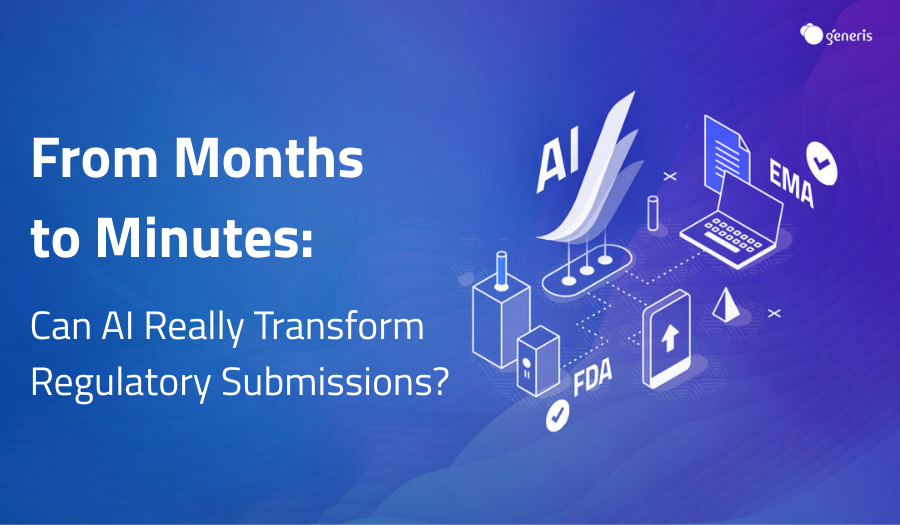From Months to Minutes: Can AI Really Transform Regulatory Submissions?
For regulatory professionals, the idea of cutting hundreds of hours of painstaking work down to just a few clicks has always felt out of reach. Imagine Module 2 and Module 3 documents generated directly from data. Product labels compared across languages in the time it takes to boil the kettle. Health Authority questions arriving pre-matched with draft responses, drawn from previous submissions.
Pharmaceutical companies are under pressure to use AI to make visions like this a reality, and to do it fast. But too often, the tools they choose deliver little real return: gimmicky solutions that take months to implement, fail to fit existing workflows, and ultimately fall short of their promises.
So, can AI really transform regulatory submissions? Can it turn these far-fetched hopes into reality for regulatory teams?
The answer is yes. And it’s happening right now.
The AI Advantage: CARA Delivers in Minutes
Traditionally, submission writing is a slow, painful process:
- Small molecule generics (simple QOS): 2-4 weeks (40-120 writer hours), assuming CMC data are complete.
- New chemical entity NDAs: 8–12 weeks (200–400 hours), often spread across 2–3 months due to data verification, QC, and multiple review cycles.
- Biologics submissions (BLAs): 3–6 months (500–1,000+ hours), complicated by multiple expression systems, manufacturing sites, comparability studies, and stability data.
But with advanced GenAI built directly into a secure, unified submission platform, CARA completes in 2 minutes what would normally take weeks, if not months.
Even with a thorough human review of around 50 hours, the time and cost savings are staggering:
- Time saved per submission: 70-1,000+ hours.
- Cost savings: £4,000-£60,000 per submission.
- Annual savings (for organisations with 1,000-2,000 submissions): up to £60 million.
And the greater benefit? Every month shaved off the timeline of clinical trial to approval translates into £3 million per day of potential product revenue. Or, according to McKinsey, filing just one month faster on a $1 billion asset can unlock around $60 million in net present value (NPV).
How it Works
Too many GenAI solutions are standalone siloes, disconnected from the wider IT architecture. But for AI to produce submission ready documents, the model itself isn’t enough. What matters most is the foundation it’s built upon.
All of the source content and data live inside the CARA Platform, where they’re already stored, structured, and indexed for optimum AI processing. Because the AI is drawing only from this governed environment, it can generate documents like Module 2 and Module 3 with far greater accuracy and consistency than a generic tool trained on loose uploads. In practice, that means the output isn’t just a “draft to fix” but instead already aligned with submission standards, accurate, and ready for expert review.
The secret is simple: CARA doesn’t bolt AI on top of messy data. It builds AI on top of a trusted platform that’s designed to manage regulatory content from the ground up. Relying not on the power of the AI model, but the strength of the platform underneath it.
Making AI Work for Life Sciences
Regulatory submissions are one of the most resource-intensive pain points in drug development. But AI can only ease the strain if it’s built for the reality of the life sciences industry; work that involves highly confidential data, strict compliance standards, and complex review cycles.
So businesses need purpose-built AI solutions, from established vendors with real expertise and experience in the life sciences sector. Because solutions must be secure, maintain compliance, and built to protect the vast amounts of confidential data handled in processes every single day. If not, organisations may find themselves pushing a very expensive square peg into a round hole.
Because CARA AI is built directly into the CARA Platform, it naturally inherits the world-class security, governance, and compliance features that some of the leading names in life sciences already trust:
- Documents never leave CARA, ensuring full data security and confidentiality
- Access control and permissions are managed centrally
- Version control and audit trails are automatic, guaranteeing traceability
- Accessibility is built-in, allowing teams to collaborate efficiently within a single platform.
Regulatory submissions don’t operate in a vacuum. It’s a process that often spans countless departments, teams, and systems. So, critically, CARA AI is not a closed system. It can integrate seamlessly with other enterprise systems to serve as an AI layer across the entire organisation, from R&D and regulatory, to safety, quality, and beyond.
CARA AI is not a closed system. It can integrate seamlessly with other enterprise systems to serve as an AI layer across the entire organisation, from R&D and regulatory, to safety, quality, and beyond.
CARA AI Goes Beyond Submissions
CARA AI offers more than a single use case. It can be ingrained into numerous processes across an organisation:
Document Classification & Metadata Enhancement
Automatically classify documents and enrich metadata, improving search and legacy content management.
Automated Data Extraction & Translation
Extract and translate critical information such as queries from health authorities, drug labels, and reports.
AI-Driven Summaries & Content Querying
Instantly summarise documents and surface key insights with natural-language queries.
Content Generation & Monitoring
From safety reports to clinical protocols, use CARA AI to generate content while monitoring usage patterns and forecasting activities to improve efficiency and security.
AI does have the power to transform the submissions process, so it no longer needs to be a bottleneck. With CARA AI, what was once a slow, resource-heavy process becomes faster, more accurate, and fully compliant. By combining advanced GenAI capabilities with a secure, unified submission platform, Generis enables life sciences companies to reduce costs, streamline submissions, and—most importantly—bring therapies to patients sooner.


